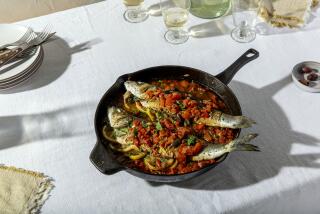Americans’ diets improve, but ethnic and income gaps widen
- Share via
More American adults are eating better, but a new analysis of American diets between 2000 and 2012 shows that the trend of improved nutrition is largely limited to middle- and upper-income white Americans. The result: a widening nutrition gap separating white Americans from African Americans and Mexican Americans.
Over the years studied, Americans 20 and older reduced their intake of sugar-sweetened sodas by nearly half, says the research published Tuesday in the journal JAMA. They came close to doubling their consumption of whole grains. And they began eating nuts and seeds a little more frequently, the study found.
Adults in the United States modestly boosted their intake of fish and shellfish. But they largely turned a deaf ear to advice to eat more fruits and vegetables and trim their consumption of red meat and processed meats, the research shows.
All told, the proportion of American adults whose diets were assessed as “poor” decreased from 55.9% in 2000 to 45.6% in 2012, and the proportion whose diets were considered middling rose from 43.5% to 53.9% over the same period. The tiny remaining fraction of U.S. adults — 0.6% in 2000 and 0.5% in 2012 — followed dietary patterns deemed by the American Heart Assn. to be “ideal” for promoting cardiovascular and metabolic health.
See the most-read stories in Science this hour »
“Getting people to eat right is not a simple task,” wrote Dr. Margo Denke, a Texas endocrinologist and general internist, in an editorial published Tuesday in JAMA. “Habits often change slowly, and rational discussions about the harm poor habits create may not be an effective motivator for long-term change.” Patients, their doctors, and the food industry need to work together to make “meaningful dietary changes” possible and sustainable, she wrote.
The new study is based on 24-hour dietary recall reports, elicited for a few days every few years from close to 34,000 American adults. The National Health and Nutrition Examination Survey (NHANES), a federally-funded gauge of consumption and other health-related behaviors, has been widely criticized for using unreliable methods. It relies heavily on respondents’ imperfect memories and their desire to burnish their images by exaggerating positive behaviors and minimizing less healthy ones. But it has changed little over the years.
Men and women alike upgraded the quality of their diets from poor to intermediate, and improvement was seen across all age groups. But progress was far more uneven when broken down along ethnic lines. Non-Latino blacks and Mexican Americans — the only two minority ethnic groups to be studied in the latest effort — were significantly less likely to have upgraded the quality of their diets than were non-Latino whites.
Among white American adults, roughly 1 in 5 of those who had poor diets in the year 2000 were found to have pushed their nutrition into the intermediate category by 2012. Among Mexican Americans and African Americans, only 1 in 10 had made the same improvement during the study period.
And that slower rate of improvement came against the backdrop of poorer diets to begin with among Mexican and African Americans: While 53.9% of whites had diets considered to be poor in 2000, 64.7% of blacks and 66% of Mexican Americans started the study period with poor-quality diets.
Denke pointed to a welter of initiatives as holding promise to promote change. Those included offering fresh fruits and vegetables at food banks and food-distribution practices that get nearly-expired fresh foods to low-income neighborhoods for sale at discount prices.
The new study, Denke wrote, “highlights how barriers of race, low income and poor education can reduce adherence to a healthy diet.” But it also provides a report card against which future efforts to promote nutritional improvements can be measured.
Follow me on Twitter @LATMelissaHealy and “like” Los Angeles Times Science & Health on Facebook.
MORE IN SCIENCE
Could wear-and-tear on the love hormone gene make us less social?
The science behind this crazy heat wave
To make chocolate healthier and tastier, all you need is an electric beam







